Reconciling the Mismatch: Creating a Regenerative Framework for Regional Planning
Abstract
1. Introduction
2. Background
2.1. Spatial Planning Discourse
2.2. Regenerative Thinking
- Give new life or energy; to revitalize; to bring or come into renewed existence; to impart new and more vigorous life;
- Form, construct, or create anew, especially in an improved state; to restore to a better, higher, or more worthy state; refreshed or renewed;
- Reform spiritually or morally; to improve moral condition; to invest with a new and higher spiritual nature;
- Improve a place or system, especially by making it more active or successful.
2.2.1. Regenerative Design
2.2.2. Urban Regeneration
2.2.3. Regenerative Development
- Improving the health and vitality of human and natural communities—physical, psychological, economic, and ecological;
- Producing and reinvesting surplus resources and energy to build the capacity of the underlying relationships and support systems of a place needed for the resilience and continuing evolution of those communities;
- Creating a field of caring for, commitment, and deep connection to places that enables the changes required for the above to take place and to endure and evolve through time [55].
2.2.4. Regenerative Culture
3. Methodology
3.1. Investigation of Regenerative Frameworks
- a.
- The first stage was to undertake a literature and Google search for existing frameworks (using the terms regenerative, regeneration, and framework).
- b.
- A selection of the found frameworks was made based on the following criteria:
- -
- What are the dimensions used in the framework: does it include spatial or time dimensions, does it relate to cultural, physical, or social dimensions, is it nature driven or human centric?
- -
- What are the main fields of attention: is it focused on socio-psychological or transformational processes, which content is part of it, do spaces, places, and areas play a role?
- -
- What are the key characteristics of the framework: which principles for regeneration are distinguished?
- -
- What keywords represent these characteristics?
The following frameworks were selected: the civic transformation framework [31], the four returns framework [48], the regenesis framework [42], five key principles for regeneration [43], biomimicry design lenses [45], worldview shift and transformed relationships [58], eight principles for a regenerative future [48], and regenerative design [47]. This selection includes traditional, well-established frameworks, such as the regenesis framework [42], which are combined with frameworks in the field of civic transformation [31], landscape [48], or biomimicry [45]. This selection also implies that not all frameworks could be included, such as the LENSES framework [59,60], certification programs [61] such as LEED, Greenstar, and BREEAM [62,63], or the living building challenge [64]. - c.
- The key concepts were identified. Every framework has specific characteristics and focus. In abstraction, their main vocabulary is often represented in a diagram that shows the interrelations and coherence between all the parts. These terms were identified and selected to be included in the integration framework.
- d.
- Integration of concepts. The compilation of frameworks was undertaken by understanding the abstraction level of each of the frameworks. Some are generic while others are more specific. The sequence for creating the integration started with the generic and included the specific ones after.
- e.
- Simplification of the framework was needed because of the large number of key concepts. The method in this last step was to cluster the key concepts into a couple of coherent groups, which were predefined (what, who, when and how). Each key concept was linked to one of these clusters.
3.2. Investigation of Urban Regions
- The search for urban regions was carried out by searching the network, both online and through the academic networks of the authors.
- The selection of urban regions was based on several criteria: geographical spread over continents, climatic and landscape variety, different cultural backgrounds, a range of socio-economical stages of development, different political systems, and size of the population. Willingness to participate in this investigation and availability to provide the geographical data and participation in the workshop were also important. In total, nine regions were selected: Monterrey (MEX), London (UK), Kharkiv (UKR), Pretoria (SA), Guadalajara (MEX), Port Moresby (PNG), Randstad (NL), Medellin (COL), and Queretaro (MEX).
- For each city, the key planning drivers were mapped. Each urban region was mapped at the same scale and the same size of 80 × 80 km. Although this size might appear arbitrary, it was chosen because all regions with their urban cores and urban–rural fringes fit in this square. Moreover, the relationship between urban settlements and the surrounding landscape could be included within this area. In every urban region, local experts were asked to deliver basic information about their region. The following layers were collected and used to integrate into one map per region:
- -
- Elevation contours illustrating the steepness of slopes connecting these with the main green and natural spaces and the existing urban area;
- -
- The space for the existing water system, including the main waterways (rivers and creeks), and the boundaries of (sub)watersheds;
- -
- Current biodiversity, existing ecosystems, and forests;
- -
- Possible areas for the development of new forests;
- -
- Existing urban agriculture practices in the urban, peri-urban, and urban regions;
- -
- Historic urban growth or decline in development stages of roughly 10–20 years, if possible, including the expected urban development;
- -
- Main infrastructure, such as public transport and the main road system.
Every map had the same legend/key, which was necessary to make all regions comparable. The maps were finalized centrally to make sure the maps were similar. - Each region was different but showed the same aspects on the maps. In this step, the findings of every region were integrated. For this integration, representatives came together for an intensive workshop of six hours during the International Symposium of Regenerative Regions, held in Monterrey in March 2024. During this symposium, the regional maps were presented, and the planning drivers of each region were discussed and ranked by the experts. The higher the rank, the more significance for creating a regenerative region. Moreover, in a separate discussion, other major driving forces were identified that shape an urban region.
4. Results
4.1. Regenerative Frameworks
- The transition from objects to agents. Everything, human beings and non-human organisms, has agency in reimagining the relationships with the land, built on care, mutuality, and reciprocity.
- From externalities to entanglements. Because everything is connected to everything [69], the current economic definition of value denies the complex system of relationships. The complex entanglement of relationships between agents determines the value of all individual species, geographies, and the biodiversity of ecosystems.
- From the private–public dichotomy to commoning. Global challenges such as pandemics, climate change, or growing inequality transcend our constructs of boundaries, departments, and disciplines and cannot be solved by the government or the private sector. Therefore, decision making over shared resources should be reconsidered. Commoning (or becoming in common [70]), could guide planetary collaboration, the way resources, materials, and spaces are used, and how shared risks could be solved.
4.2. Regenerative Regions
4.3. Regenerative Framework for Regional Planning
- Understanding the past, present, and future of the region (the ‘when’) by mapping the backtracked equilibrium [77]. In search of a sustainable balance between the natural conditions and the socio-economic system, traditional knowledge about the relationship to country of indigenous peoples, at a time when first settlers started to build the city [71,72], was used. The map shows the natural resources and their reciprocal relationships with the use of resources in the early settlement, understanding the natural, urban, and social origins of the region. This explains how their relationship to country determined how people used resources, and how their reciprocal relationship with their environment established the sustainable equilibrium. This first-generation city [78] was the moment that the first settlers encountered the place and built a small settlement. Often these settlers were indigenous people, who in many cases were nomadic and stayed in different places in the region.
- Once this equilibrium was understood, it could be used as an inspiration to design the desired future for the area (Figure 11(2a)). For this third-generation city [78], the future can be twofold. Either the region will fall into ruins and nature re-occupies the place, eventually returning it to a natural reserve, or, the region continuously reestablishes an equilibrium in which natural and human resources are constantly regenerated. This requires planned flexibility and the establishment of adaptive processes, which allow nature to guide and direct urban uses in the city. As the urban regions highlighted, this starts with the natural aspects (landscape, elevation, water, and ecology), the elements that are essential to guarantee life in the long term. Secondly, the way landownership and politics support these aspects guide choices about land use. Within this spatial structure, social aspects were allocated, such as where food was grown and housing fit. Finally, the supportive infrastructure and the working locations and industry could be placed in the remaining spaces. All attributes of the systems of place (Figure 11) were applied in order to map out which specific regenerative potentials should be deployed, emphasizing the way people in the future reciprocally use the available resources. The desired future of the area told the story of place in a landscape plan, which communed and integrated the socio-ecological city-region as a diverse living system. It provided natural and social returns and harvested what the land provides (Figure 11(2a)). During this second stage, it was essential to design the process with which to envision this desired future (Figure 11(2b)), using the attributes of developing the right mind to establish a shared understanding about the future amongst a selected group of interested partners who want to take responsibility.
- Once the desired future was mapped, the differences with the current, second-generation city [78] were identified. This second-generation city is the region as we know it now; often an industrialized, anthropogenic city driven by economic forces and degenerating its environment. After mapping the natural, social, and economic systems of the current city, these could be compared with the same systems in the desired future (Figure 11(3a)). Again, all attributes of the systems of place were used here. The required change was the difference between the desired future and the current situation. Following this, the process of how this transformation from current to future can be achieved used all attributes of the value adding processes (Figure 11(3b)), enhancing the complex processes of adaptation, emergence, and reciprocity, so local responses could be effectively implemented. Finally, the agency of local interested groups was brought in, which have a shared understanding and the capacity of internal regeneration to establish landscape partnerships and social returns (Figure 11(3c)), the attributes of developing the right mind.In this way, the regenerative framework for regional planning started from understanding the basic balances in the region as a basis for creating a shared future vision, which then, by comparison, showed the gaps and transformation needed for reaching that future, the ways this can be achieved, and the agents who are required to realize that shared future. Within the framework, several feedback loops were included to reconnect the latter stages with the first ones.
5. Discussion
6. Conclusions
Author Contributions
Funding
Data Availability Statement
Acknowledgments
Conflicts of Interest
References
- Henig, D.; Knight, D.M. Polycrisis: Prompts for an emerging worldview. Anthropol. Today 2023, 39, 3–6. [Google Scholar] [CrossRef]
- Hoyer, D.; Bennett, J.S.; Reddish, J.; Holder, S.; Howard, R.; Benam, M.; Levine, J.; Ludlow, F.; Feinman, G.; Turchin, P. Navigating polycrisis: Long-run socio-cultural factors shape response to changing climate. Philos. Trans. R. Soc. B 2023, 378, 20220402. [Google Scholar] [CrossRef]
- Lawrence, M.; Homer-Dixon, T.; Janzwood, S.; Rockstöm, J.; Renn, O.; Donges, J.F. Global Polycrisis: The causal mechanisms of crisis entanglement. Glob. Sustain. 2024, 7, e6. [Google Scholar] [CrossRef]
- Crutzen, P.J.; Stoermer, E.F. The Anthropocene. Glob. Chang. Newsl. 2000, 41, 17–18. [Google Scholar]
- Edwards, L.E. What is the Anthropocene. Eos 2015, 96, 6–7. [Google Scholar] [CrossRef]
- Almond, R.E.; Grooten, M.; Peterson, T. Living Planet Report 2020-Bending the Curve of Biodiversity Loss; World Wildlife Fund: Gland, Switzerland, 2020. [Google Scholar]
- Chew, S.C. World Ecological Degradation: Accumulation, Urbanization, and Deforestation, 3000 BC-AD 2000; Rowman Altamira: Lanham, MD, USA, 2001. [Google Scholar]
- IPCC. Climate Change 2023: Synthesis Report. In Contribution of Working Groups I, II and III to the Sixth Assessment Report of the Intergovernmental Panel on Climate Change; Core Writing Team, Lee, H., Romero, J., Eds.; IPCC: Geneva, Switzerland, 2023; p. 184. [Google Scholar] [CrossRef]
- Koch, A.; McBratney, A.; Adams, M.; Field, D.; Hill, R.; Crawford, J.; Minasny, B.; Lal, R.; Abbott, L.; O’Donnell, A.; et al. Soil security: Solving the global soil crisis. Glob. Policy 2013, 4, 434–441. [Google Scholar] [CrossRef]
- Zika, M.; Erb, K.H. The global loss of net primary production resulting from human-induced soil degradation in drylands. Ecol. Econ. 2009, 69, 310–318. [Google Scholar] [CrossRef]
- Falkenmark, M.; Wang-Erlandsson, L.; Rockström, J. Understanding of water resilience in the Anthropocene. J. Hydrol. X 2019, 2, 100009. [Google Scholar] [CrossRef]
- Rockström, J.; Falkenmark, M.; Allan, T.; Folke, C.; Gordon, L.; Jägerskog, A.; Kummu, M.; Lannerstad, M.; Meybeck, M.; Molden, D.; et al. The unfolding water drama in the Anthropocene: Towards a resilience-based perspective on water for global sustainability. Ecohydrology 2014, 7, 1249–1261. [Google Scholar] [CrossRef]
- Lampert, A. Over-exploitation of natural resources is followed by inevitable declines in economic growth and discount rate. Nat. Commun. 2019, 10, 1419. [Google Scholar] [CrossRef]
- Mittal, I.; Gupta, R.K. Natural resources depletion and economic growth in present era. SOCH-Mastnath J. Sci. Technol. 2015, 10, 24–28. [Google Scholar]
- Chase-Dunn, C.; Lawrence, K.S. The next three futures, part one: Looming crises of global inequality, ecological degradation, and a failed system of global governance. Glob. Soc. 2011, 25, 137–153. [Google Scholar] [CrossRef]
- Sernau, S. Worlds Apart: Social Inequalities in a Global Economy; Pine Forge Press: Thousand Oaks, CA, USA, 2006. [Google Scholar]
- Weiß, A. Global Social Inequalities. In Global Handbook of Inequality; Springer International Publishing: Cham, Switzerland, 2023; pp. 1–15. [Google Scholar]
- Krishnan, S.; Aydin, N.Y.; Comes, T. TIMEWISE: Temporal Dynamics for Urban Resilience theoretical insights and empirical reflections from Amsterdam and Mumbai. NPJ Urban Sustain. 2024, 4, 4. [Google Scholar] [CrossRef]
- Rega, C. Ecological Rationality in Spatial Planning: Concepts and Tools for Sustainable Land-Use Decisions (Cities and Nature); Springer: London, UK, 2020. [Google Scholar]
- Lai, S.; Zoppi, C. Sustainable Spatial Planning Based on Ecosystem Services, Green Infrastructure and Nature-Based Solutions. Sustainability 2024, 16, 2591. [Google Scholar] [CrossRef]
- EEA. Exiting the Anthropocene? Exploring Fundamental Change in Our Relationship with Nature. Briefing. 2023. Available online: https://www.eea.europa.eu/publications/exiting-the-anthropocene/ (accessed on 14 April 2024).
- Bekker, A.; Po, C.; Chang, F.-J. Radicle Civics—Building Proofs of Possibilities for a Civic Economy and Society. Dark Matter, 14 August 2023. Available online: https://provocations.darkmatterlabs.org/radicle-civics-building-proofs-of-possibilities-for-a-civic-economy-and-society-ee28baeeec70 (accessed on 2 April 2024).
- Wahl, D.C. Designing Regenerative Cultures; Triarchy Press: Axminster, UK, 2016. [Google Scholar]
- Albrecht, G. Exiting the Anthropocene and Entering the Symbiocene. 2015. Available online: https://glennaalbrecht.wordpress.com/2015/12/17/exiting-the-anthropocene-and-entering-the-symbiocene/ (accessed on 14 April 2024).
- Næss, A. The shallow and the deep, long-range ecology movement: A summary. Inquiry 1973, 16, 95–100. [Google Scholar] [CrossRef]
- Næss, A. Self-realization: An ecological approach to being in the world. In Deep Ecology for the Twenty-First Century; Sessions, G., Ed.; Shambhala: London, UK, 1995; pp. 225–239. [Google Scholar]
- Turner, R.K. Sustainability: Principles and practices. In Sustainable Environmental Economics and Management: Principles and Practice; Turner, R.K., Ed.; Belhaven Press: New York, NY, USA; London, UK, 1993; pp. 3–36. [Google Scholar]
- Haraway, D. Staying with the Trouble: Making Kin in the Chthulucene; Duke University Press: Durham, NC, USA, 2016. [Google Scholar]
- EESC. Towards an EU Charter of the Fundamental Rights of Nature—Study. 2019. Available online: https://www.eesc.europa.eu/sites/default/files/files/qe-03-20-586-en-n.pdf (accessed on 15 April 2024).
- Cole, R.J.; Oliver, A.; Robinson, J. Regenerative design, socio-ecological systems and co-evolution. Build. Res. Inf. 2013, 41, 237–247. [Google Scholar] [CrossRef]
- Oliver, T. The Self Delusion: The Surprising Science of How We Are Connected and Why That Matters; Weidenfeld & Nicolson Ltd.: London, UK, 2020. [Google Scholar]
- McLoughlin, B. Urban and Regional Planning: A Systems Approach; Faber & Faber: London, UK, 1969. [Google Scholar]
- Allmendinger, P. Planning Theory; Palgrave: New York, NY, USA, 2002. [Google Scholar]
- Allmendinger, P. Neoliberal Spatial Governance; Routledge: Abingdon, UK, 2016. [Google Scholar]
- Banfield, E.C. Ends and means in planning. Int. Soc. Sci. J. 1959, xi, 361–368. [Google Scholar]
- De Roo, G.; Rauws, W.; Zuidema, C. Rationalities for adaptive planning to address uncertainties. In Handbook on Planning and Complexity; De Roo, G., Yamu, C., Zuidema, C., Eds.; Edward Elgar Publishing: Cheltenham, UK, 2020; pp. 110–150. [Google Scholar] [CrossRef]
- Lindblom, C.E. The Science of “Muddling Through”. Public Adm. Rev. 1959, 19, 79–88. [Google Scholar] [CrossRef]
- Friedmann, J. A Conceptual Model for the Analysis of Planning Behavior. Adm. Sci. Q. 1967, 12, 225–252. [Google Scholar] [CrossRef]
- Roggema, R.E. Swarm Planning: The Development of a Spatial Planning Methodology to Deal with Climate Adaptation. Ph.D. Thesis, Delft University of Technology, Delft, The Netherlands, 2012. [Google Scholar] [CrossRef]
- Davy, B. Plan ‘it´ without a condom! Plan. Theory 2008, 7, 301–317. [Google Scholar] [CrossRef]
- Schurig, S.; Turan, K. The concept of a ‘regenerative city’: How to turn cities into regenerative systems. J. Urban Regen. Renew. 2022, 15, 161–175. [Google Scholar]
- Mang, P.; Reed, B. Regenerative Development and Design. In Encyclopedia of Sustainability Science and Technology; Meyers, R.A., Ed.; Springer: New York, NY, USA, 2012; pp. 8855–8879. [Google Scholar] [CrossRef]
- Buckton, S.J.; Fazey, I.; Sharpe, B.; Om, E.S.; Doherty, B.; Ball, P.; Denby, K.; Bryant, M.; Lait, R.; Bridle, S.; et al. The Regenerative Lens: A conceptual framework for regenerative social-ecological systems. One Earth 2023, 6, 824–842. [Google Scholar] [CrossRef]
- Camrass, K. Regenerative Futures: Eight Principles for Thinking and Practice. J. Futures Stud. 2023, 28, 88–99. Available online: https://jfsdigital.org/articles-and-essays/2023-2/vol-28-no-1-september-2023/regenerative-futures-eight-principles-for-thinking-and-practice/ (accessed on 12 April 2024).
- Stevens, L.; Kopnina, H.; Mulder, K.; De Vries, M. Biomimicry design thinking education: A base-line exercise in preconceptions of biological analogies. Int. J. Technol. Des. Educ. 2021, 31, 797–814. [Google Scholar] [CrossRef]
- Mang, P.; Haggard, B. Regenerative Development and Design: A Framework for Evolving Sustainability; John Wiley & Sons: Hoboken, NJ, USA, 2016. [Google Scholar]
- Gutiérrez Jaber, I. Regenerative Design: The Movement Aiming to Return Us to Our Roots. TEC Science, 30 June 2023. Available online: https://tecscience.tec.mx/en/human-social/regenerative-design/ (accessed on 2 April 2024).
- Dudley, N.; Baker, C.; Chatterton, P.; Ferwerda, W.H.; Gutierrez, V.; Madgwick, J. The 4 Returns Framework for Landscape Restoration; Commonland, Wetlands International Landscape Finance Lab and IUCN Commission on Ecosystem Management: Amsterdam, The Netherlands; Gland, Switzerland, 2021. [Google Scholar]
- Hes, D.; Du Plessis, C. Designing for Hope. Pathways to Regenerative Sustainability; Routledge: Abingdon, UK, 2015. [Google Scholar]
- Hawken, P. Regeneration. Ending the Climate Crisis in One Generation; Penguin Books: New York, NY, USA, 2021. [Google Scholar]
- Lyle, J.T. Regenerative Design for Sustainable Development; John Wiley and Sons: New York, NY, USA, 1994. [Google Scholar]
- Roberts, P. The evolution, definition and purpose of urban regeneration. In Urban Regeneration: A Handbook; Roberts, P., Sykes, H., Eds.; SAGE Publications: London, UK, 2000; pp. 9–36. [Google Scholar]
- Girardet, H. Creating Regenerative Cities; Routlegde: Abingdon, UK, 2015. [Google Scholar]
- Mang, N.S. Toward a Regenerative Psychology of Urban Planning; Saybrook Graduate School and Research Center: San Francisco, CA, USA, 2009; Available online: https://powersofplace.com/pdfs/Toward_a_Regenerative_Psychology_of_Urban_Planning.pdf (accessed on 15 April 2024).
- Jenkin, S.; Pedersen Zari, M. Rethinking Our Built Environments: Towards a Sustainable Future; Ministry for the Environment, Manatu Mo Te Taiao: Wellington, New Zealand, 2009. [Google Scholar]
- Gabel, M. Regenerative Development: Going Beyond Sustainability. Kosmos, Fall/Winter 2015. Available online: https://www.kosmosjournal.org/article/regenerative-development-going-beyond-sustainability/ (accessed on 27 March 2024).
- Wahl, D.C. What Are Regenerative Cultures? Resilience, 22 March 2021. Available online: https://www.resilience.org/stories/2021-03-22/what-are-regenerative-cultures/ (accessed on 27 March 2024).
- Reed, B.; Holliday, M. A Regenerative Approach to Tourism in Canada; Destination Canada: Vancouver, BC, Canada, 2023. [Google Scholar]
- Center for Living Environments and Regeneration. Lenses Overview Guide. How to Create Living Environments in Natural, Social, and Economic Systems. 2018. Available online: https://ibe.colostate.edu/wp-content/uploads/2018/07/LENSES-Overview-Guide_Facing_6.9.18.pdf (accessed on 19 April 2024).
- Plaut, J.M.; Dunbar, B.; Wackerman, A.; Hodgin, S. Regenerative design: The LENSES Framework for buildings and communities. Build. Res. Inf. 2012, 40, 112–122. [Google Scholar] [CrossRef]
- Newton, P.; Marchant, D.; Mitchell, J.; Plume, J.; Seo, S.; Roggema, R. Performance Assessment of Urban Precinct Design: A Scoping Study; CRC for Low Carbon Living: Sydney, Australia, 2013. [Google Scholar]
- Awadh, O. Sustainability and green building rating systems: LEED, BREEAM, GSAS and Estidama critical analysis. J. Build. Eng. 2017, 11, 25–29. [Google Scholar] [CrossRef]
- Gowri, K. Green building rating systems: An overview. ASHRAE J. 2004, 46, 56. [Google Scholar]
- International Living Future Institute. Book review Living Building Challenge. J. Educ. Sustain. Dev. 2012, 6, 360. [Google Scholar] [CrossRef]
- Katila, P.; Colfer, C.J.P.; De Jong, W.; Galloway, G.; Pacheco, P.; Winkel, G. (Eds.) Sustainable Development Goals; Cambridge University Press: Cambridge, UK, 2019. [Google Scholar]
- Sustainable Development Goals. Available online: https://sdgs.un.org/goals (accessed on 20 April 2024).
- Mang, P.; Reed, B. Designing from place: A regenerative framework and methodology. Build. Res. Inf. 2012, 40, 23–38. [Google Scholar] [CrossRef]
- Du Plessis, C. Towards a regenerative paradigm for the built environment. Build. Res. Inf. 2012, 40, 7–22. [Google Scholar] [CrossRef]
- Commoner, B. The Closing Circle: Nature, Man, and Technology; Alfred A. Knopf: New York, NY, USA, 1971. [Google Scholar]
- Nightingale, A.J. Commoning for inclusion? commons, exclusion, property and socio-natural becomings. Int. J. Commons 2019, 13, 16–35. [Google Scholar] [CrossRef]
- Marshall, C.A. The Role of Indigenous Paradigms and Traditional Knowledge Systems in Modern Humanity’s Sustainability Quest–Future Foundations from Past Knowledge’s. In Designing Sustainable Cities; Roggema, R., Ed.; Springer: Dordrecht, The Netherlands, 2020; pp. 17–28. [Google Scholar]
- Marshall, C.; Twill, J. Using Indigenous knowledge in climate resistance strategies for future urban environments. In Design for Regenerative Cities and Landscapes: Rebalancing Human Impact and Natural Environment; Roggema, R., Ed.; Springer: Dordrecht, The Netherlands, 2022; pp. 49–63. [Google Scholar]
- Krznaric, R. The Good Ancestor; WH Allen: London, UK, 2020. [Google Scholar]
- Roggema, R. The Eco-Cathedric City: Rethinking the Human–Nature Relation in Urbanism. Land 2023, 12, 1501. [Google Scholar] [CrossRef]
- Folke, C.; Biggs, R.; Norström, A.V.; Reyers, B.; Rockström, J. Social-ecological resilience and biosphere-based sustainability science. Ecol. Soc. 2016, 21, 41. [Google Scholar] [CrossRef]
- Rockström, J.; Sukhdev, P. How Food Connects All the SDGs. Available online: http://www.stockholmresilience.org/research/research-news/2016-06-14-how-food-connects-all-the-sdgs.html (accessed on 22 April 2024).
- Roggema, R. Shifting paradigms. In The Design Charrette: Ways to Envision Sustainable Futures; Roggema, R., Ed.; Springer Science+Business Media: Dordrecht, The Netherlands, 2014; pp. 61–95. [Google Scholar] [CrossRef]
- Casagrande, M. Third Generation City; The International Society of Biourbanism: Artena, Italy, 2013; pp. 1–4. [Google Scholar]
- Partelow, S. What is a framework? Understanding their purpose, value, development and use. J. Environ. Stud. Sci. 2023, 13, 510–519. [Google Scholar] [CrossRef]
- Cox, M.; Villamayor-Tomas, S.; Epstein, G.; Evans, L.; Ban, N.C.; Fleischman, F.; Nenadovic, M.; Garcia-Lopez, G. Synthesizing theories of natural resource management and governance. Glob. Environ. Chang. 2016, 39, 45–56. [Google Scholar] [CrossRef]
- Schlager, E. A Comparison of frameworks, theories, and models of policy processes. In Theories of the Policy Process, 1st ed.; Sabatier, P.A., Ed.; Routledge: Milton Park, UK, 2007; pp. 293–319. [Google Scholar]
- Cumming, G.S. Theoretical Frameworks for the analysis of social-ecological systems. In Social-Ecological Systems in Transition; Sakai, S., Umetsu, C., Eds.; Springer: Tokyo, Japan, 2014. [Google Scholar] [CrossRef]
- Binder, C.R.; Hinkel, J.; Bots, P.W.G.; Pahl-Wostl, C. Comparison of Frameworks for analyzing social-ecological systems. Ecol. Soc. 2013, 18, 26. [Google Scholar] [CrossRef]
- McGinnis, M.D.; Ostrom, E. Social-Ecological system framework: Initial changes and continuing challenges. Ecol. Soc. 2014, 19, 30. [Google Scholar] [CrossRef]
- Pulver, S.; Ulibarri, N.; Sobocinski, K.L.; Alexander, S.M.; Johnson, M.L.; Mccord, P.F. Frontiers in socio-environmental research: Components, connections, scale, and context. Ecol. Soc. 2018, 23, 23. [Google Scholar] [CrossRef]
- Boerboom, L.; Gibert, M.; Spaliviero, M.; Spaliviero, G. The Spatial Development Framework for Implementation of National Urban Policy. Rwanda J. Ser. D 2016, 1. [Google Scholar] [CrossRef]
- Dawson, D.A.; Vercruysse, K.; Wright, N. A spatial framework to explore needs and opportunities for interoperable urban flood management. Phil. Trans. R. Soc. A 2020, 378, 20190205. [Google Scholar] [CrossRef]
- Loidl, M.; Witzmann-Müller, U.; Zagel, B. A spatial framework for Planning station-based bike sharing systems. Eur. Transp. Res. Rev. 2019, 11, 9. [Google Scholar] [CrossRef]
- Medcalf, K.; Small, N.; Finch, C.; Williams, J.; Blair, T.; Haines-Young, R.; Potschin, M.; Parker, J. Further Development of a Spatial Framework for Mapping Ecosystem Services; JNCC: Peterborough, UK, 2014. [Google Scholar]
- Pauly, D. Anecdotes and the shifting baseline syndrome of fisheries. Trends Ecol. Evol. 1995, 10, 430. [Google Scholar] [CrossRef]
- Soga, M.; Gaston, K.J. Shifting baseline syndrome: Causes, consequences, and implications. Front. Ecol. Environ. 2018, 16, 222–230. [Google Scholar] [CrossRef]
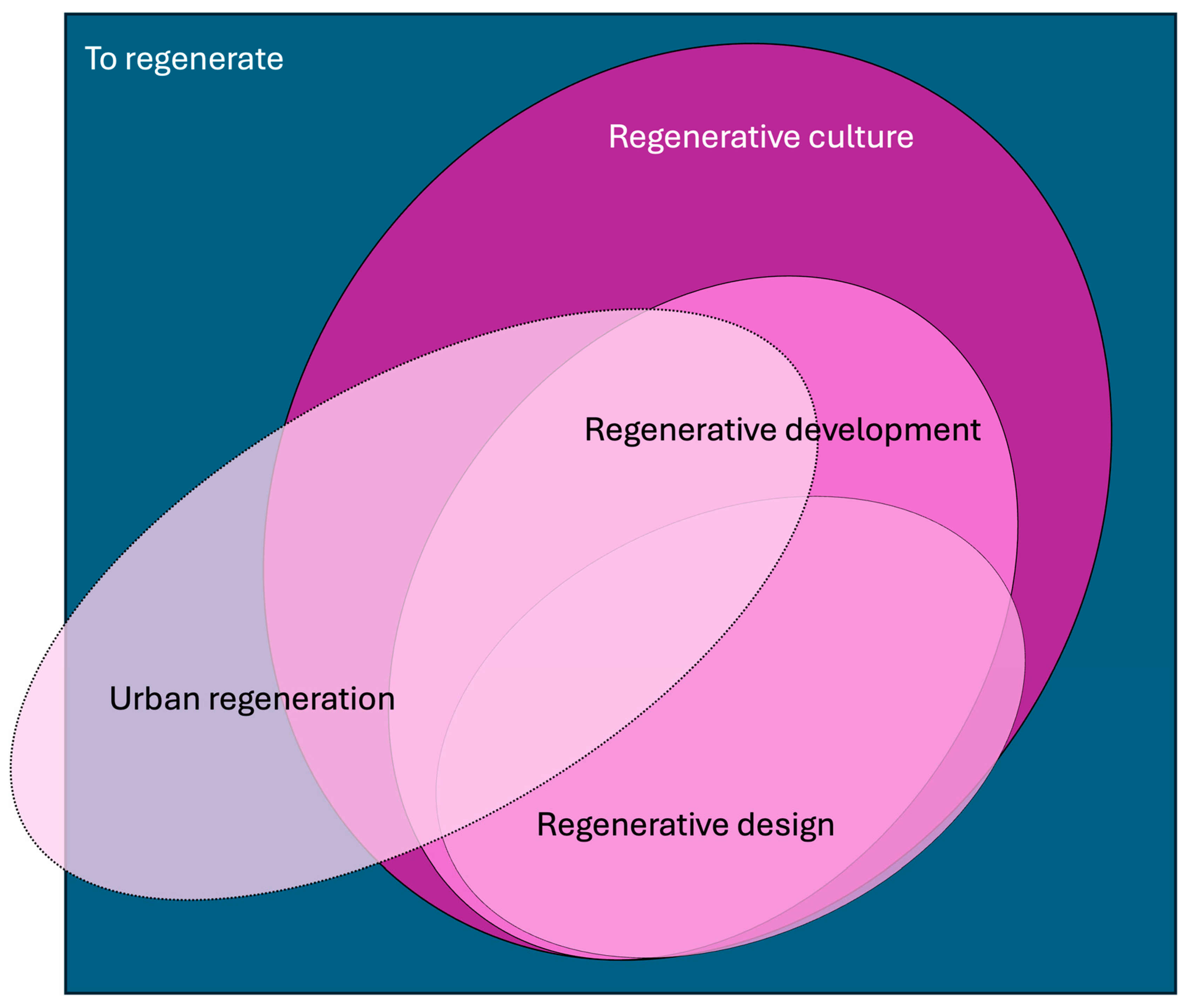
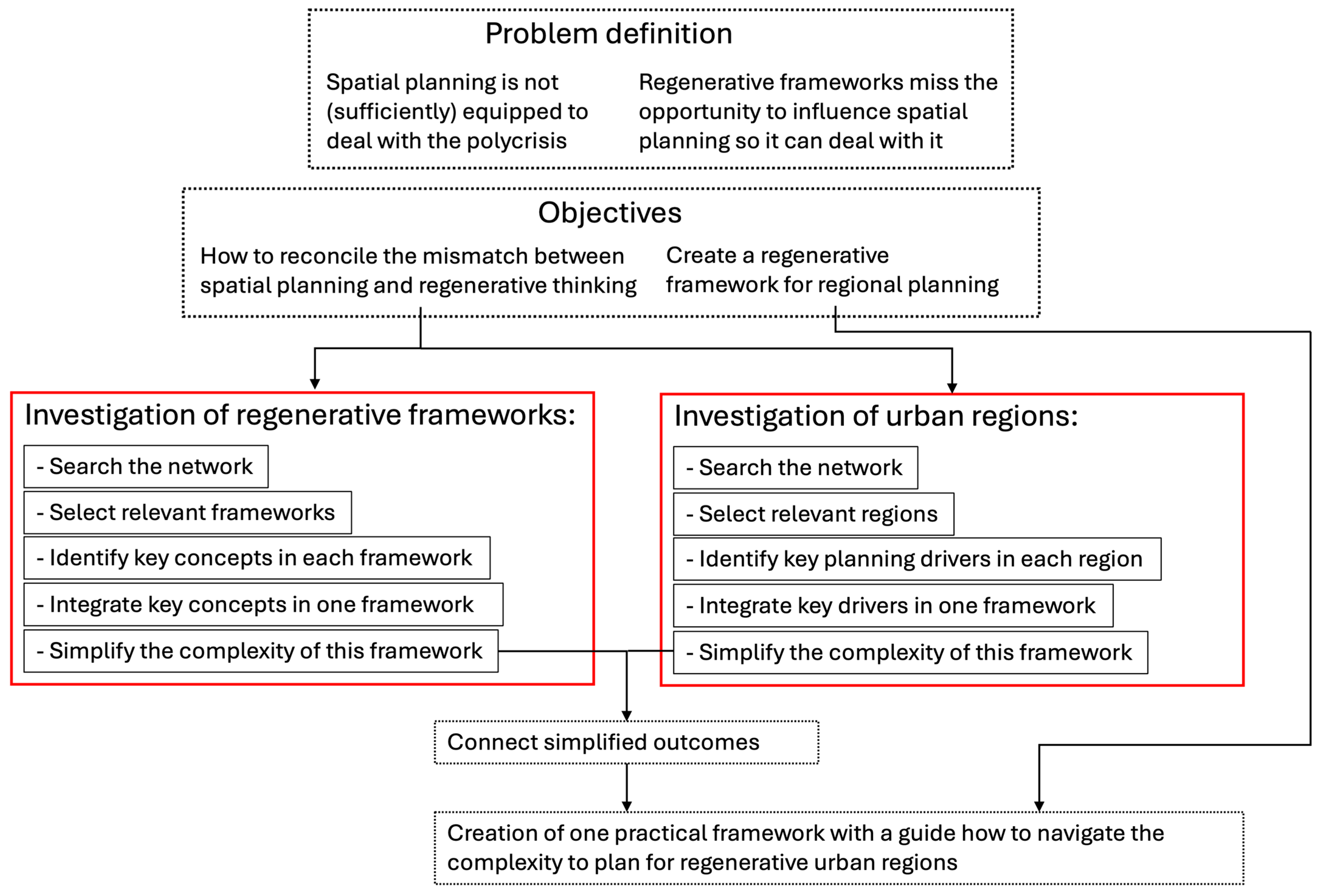
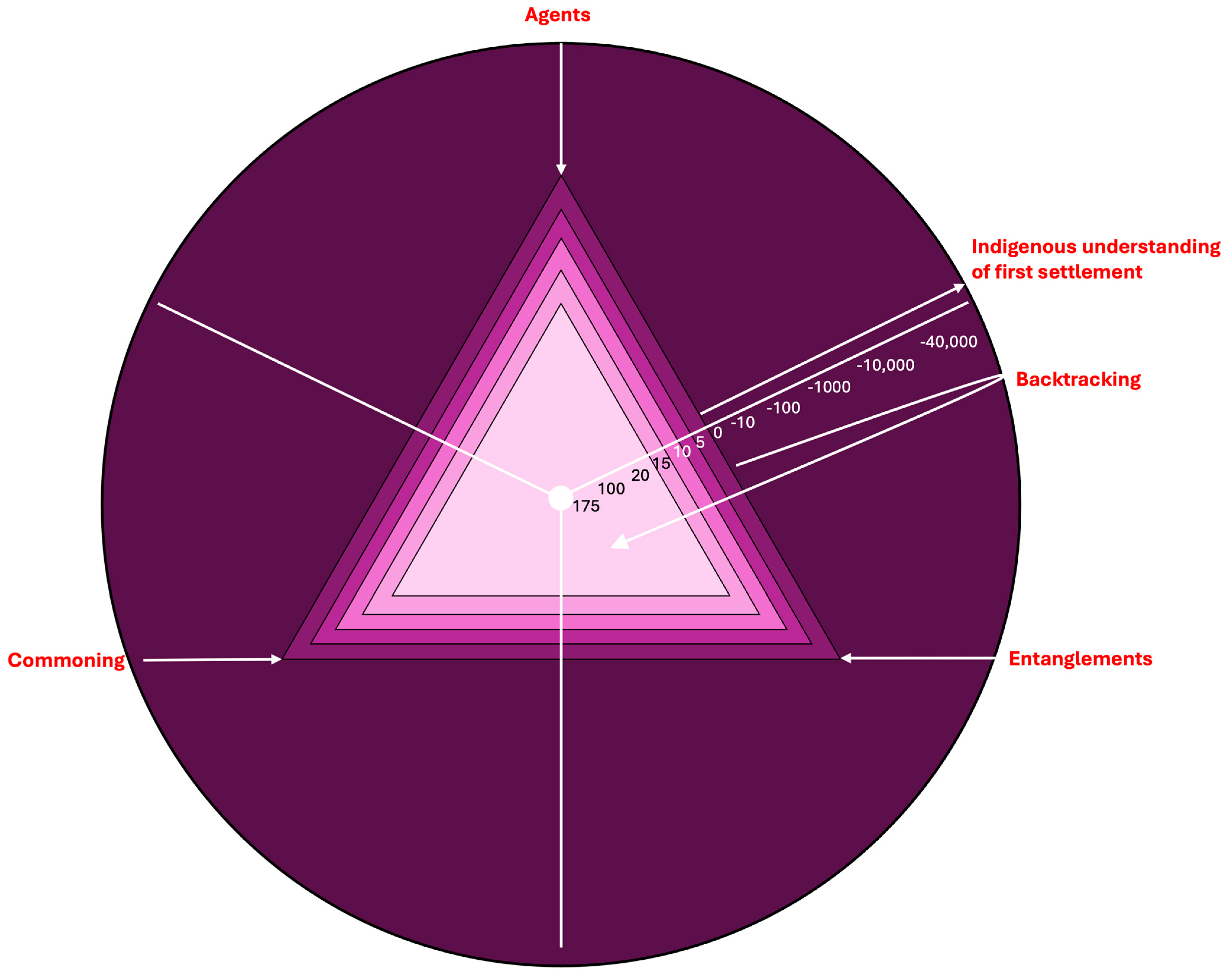

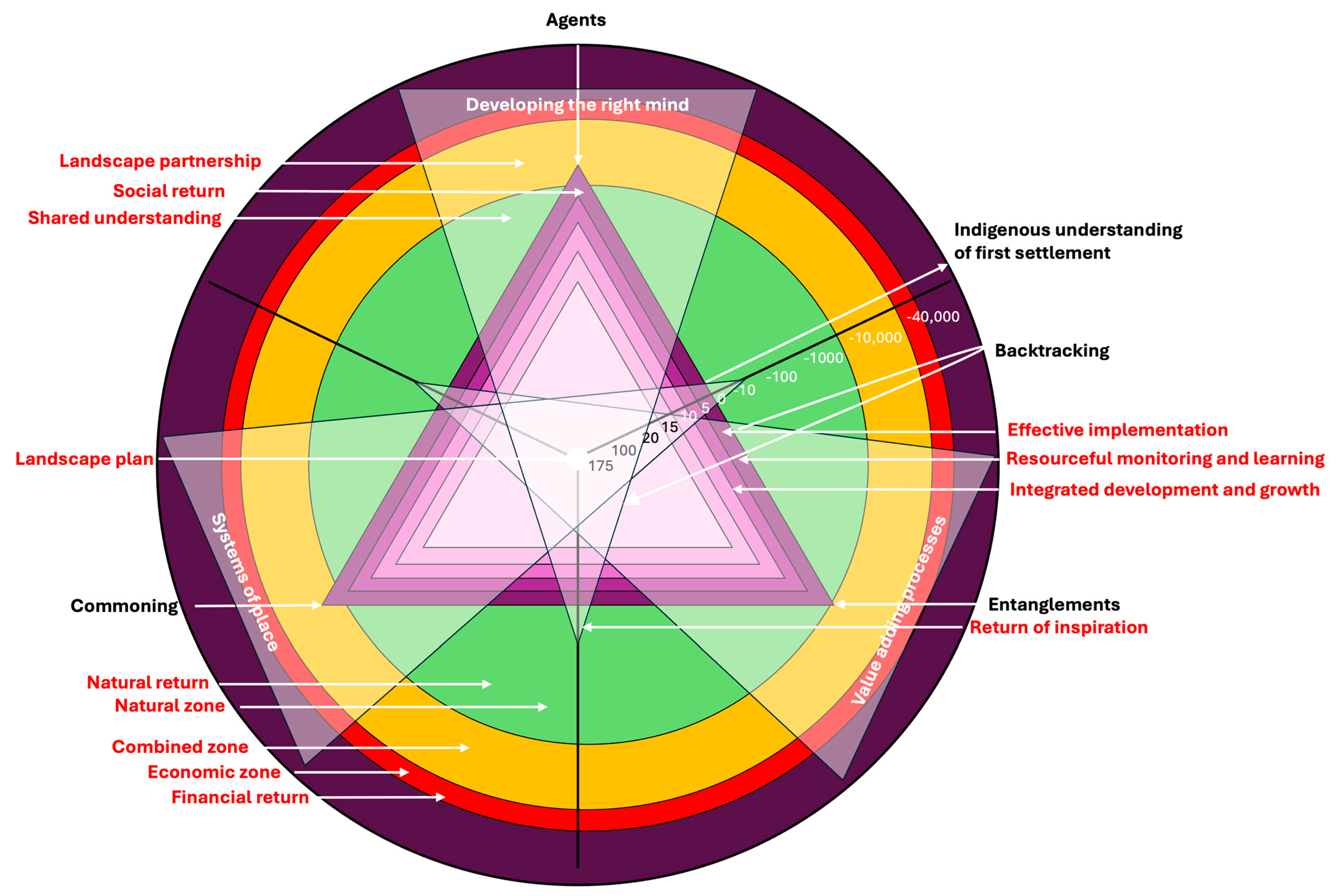
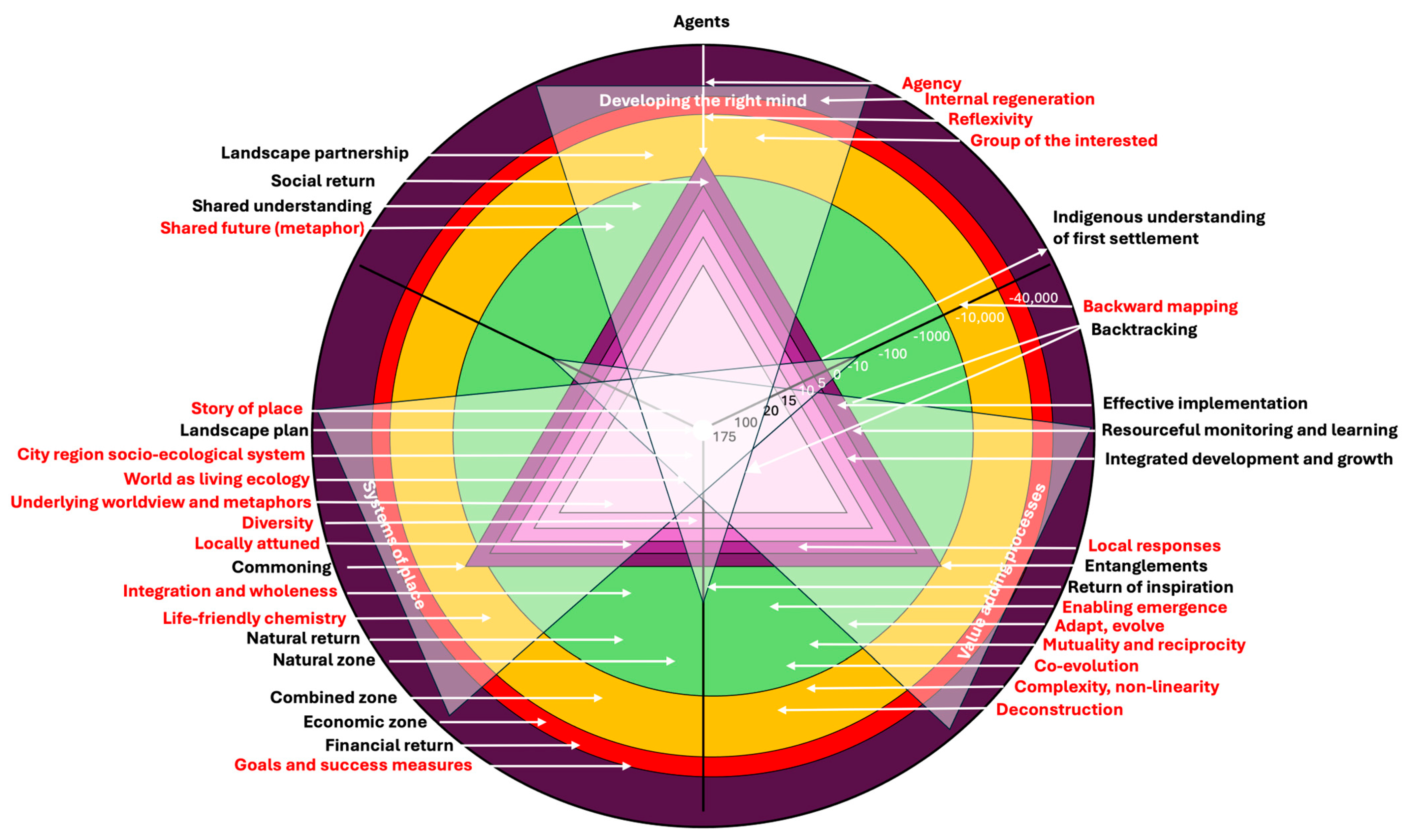
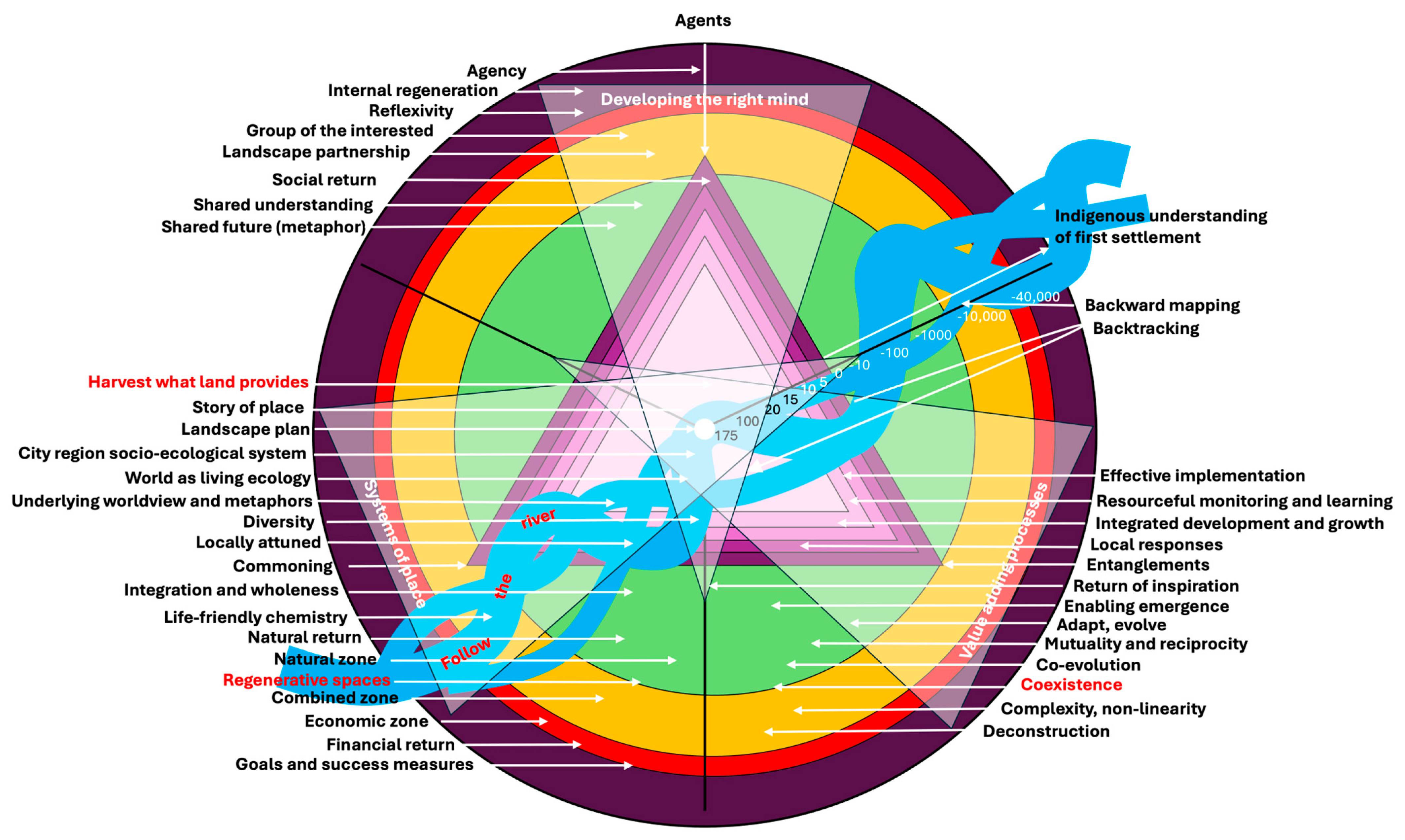
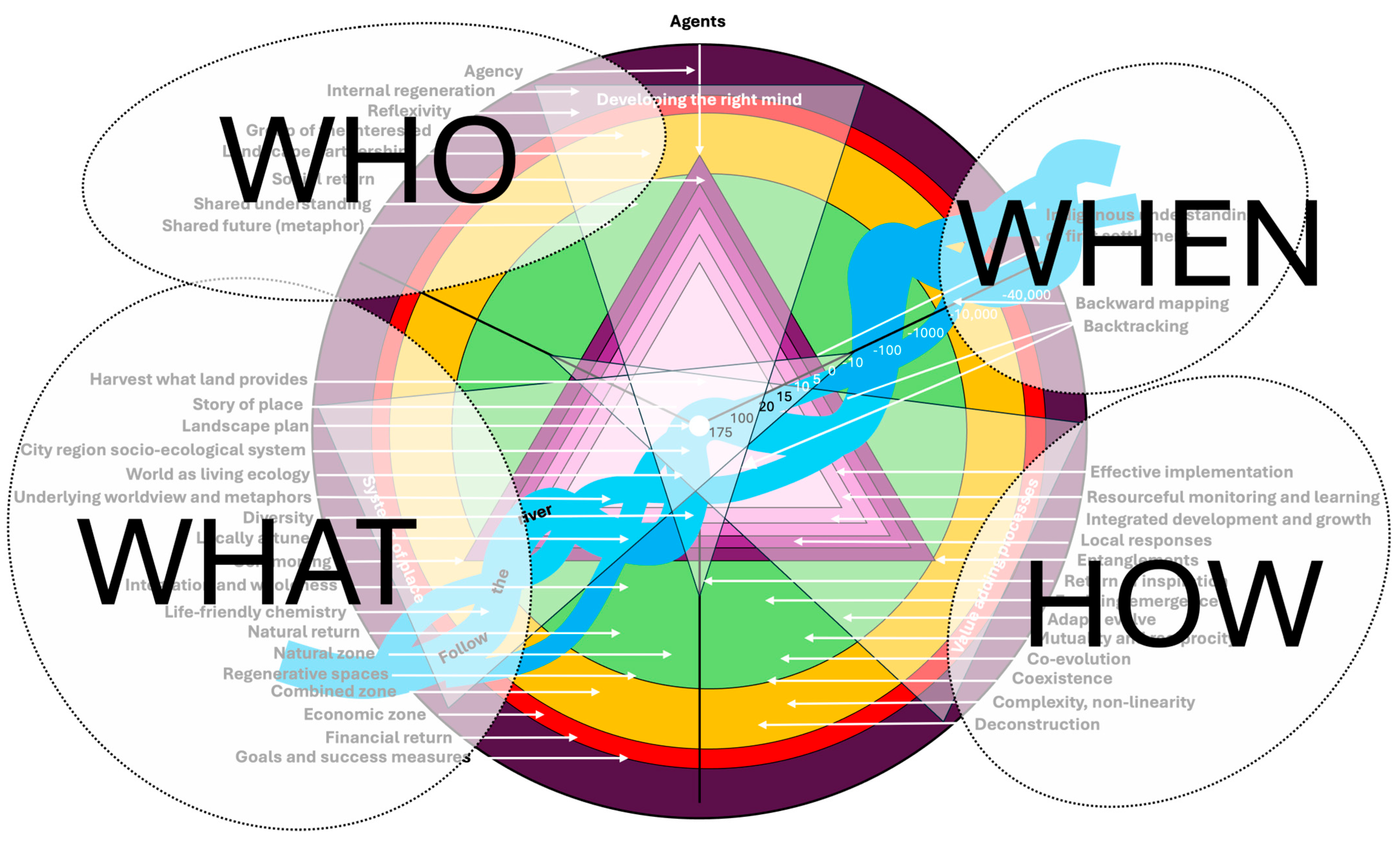

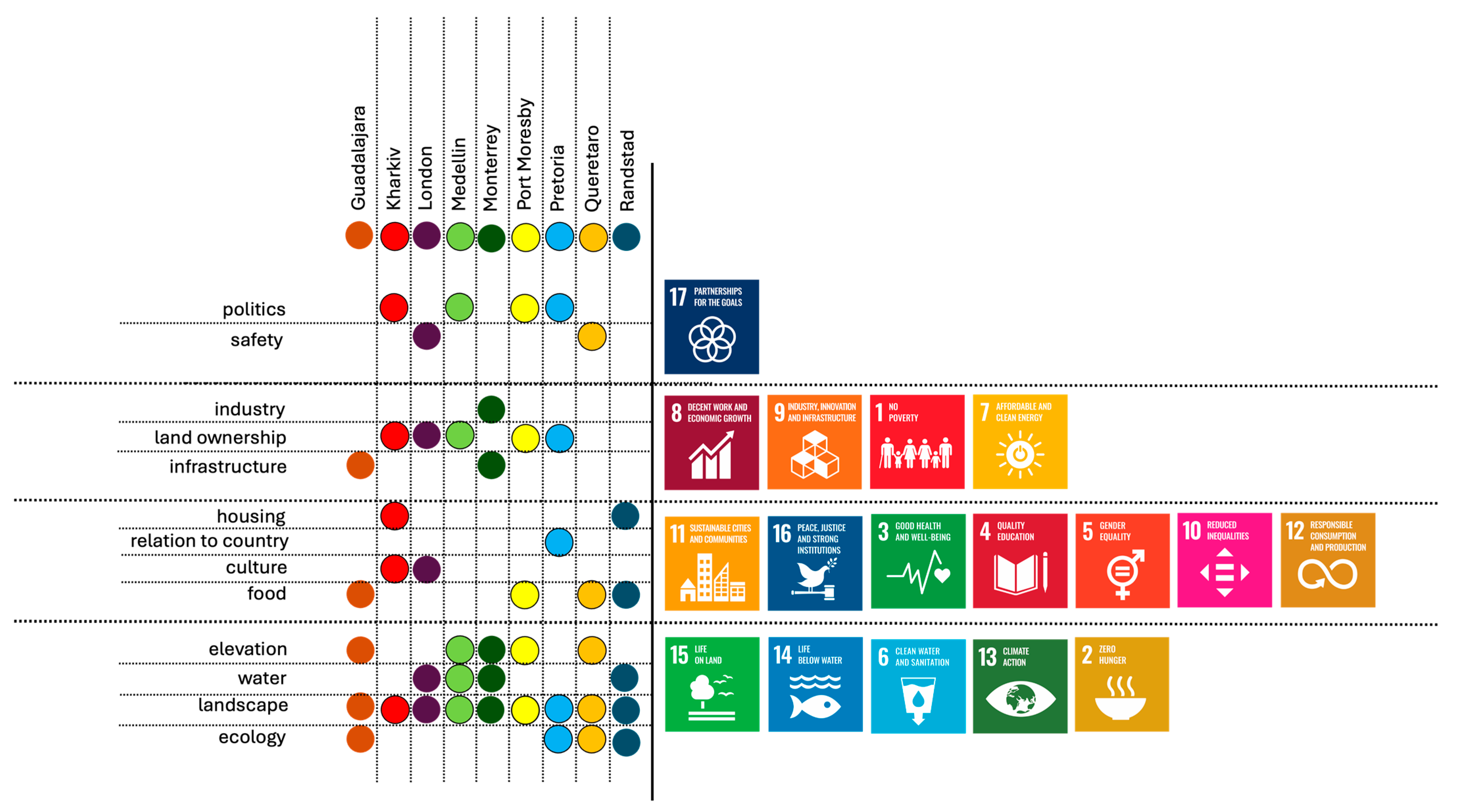
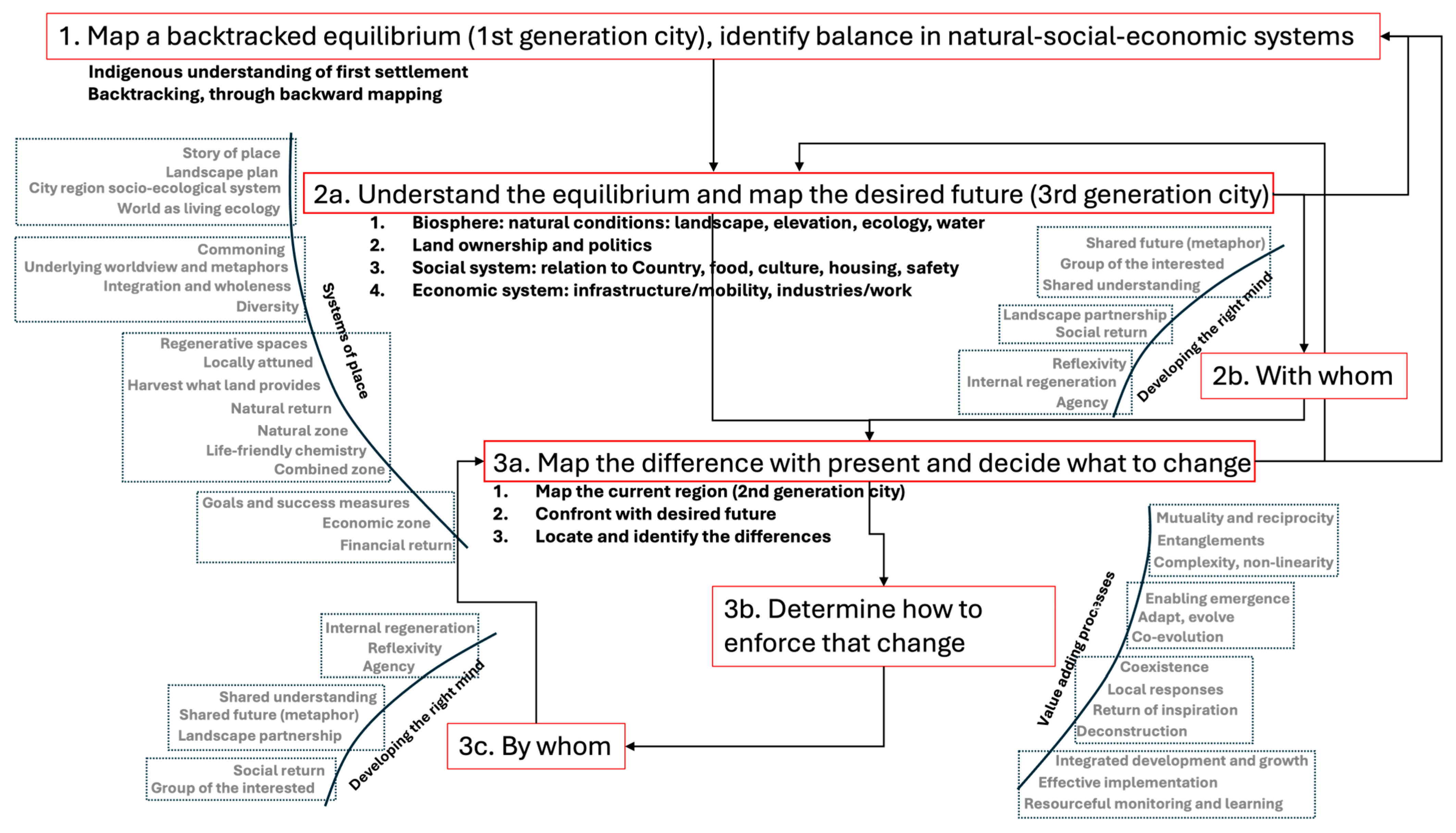
| Framework | Key Concept | Brief Description | Cluster |
|---|---|---|---|
| Civic Transformation Framework | Commoning | From private/public to commoning: resource and space use depicted by planetary collaboration and unbounded fluidity requiring new collective intelligence and social and civic capital. | WHAT |
| Entanglements | From externalities to entanglements: value comes from relationships between agents as an emergent property of a complex system of relationships. | HOW | |
| Agents | From objects to agents: reimagine ties with the land and the Earth as part of a network of relationships built on care, mutuality, and reciprocity. | WHO | |
| Backtracking | Traveling back in time to a moment of natural sustainable equilibrium | WHEN | |
| Regenesis Framework | Systems of place | Ecological, social, cultural. | WHAT |
| Value adding processes | Food and shelter, transact and adorn, recreate and commune. | HOW | |
| Developing the right mind | Functioning, being, willing. | WHO | |
| Four Returns Framework | Landscape plan | Design and build a landscape plan. | WHAT |
| Natural zone | Regenerating an ecological foundation by restoring and protecting biodiversity within natural ecosystems. | WHAT | |
| Combined zone | Combining food, fiber, and biodiversity through regenerative agriculture, agroforestry, and soil restoration. | WHAT | |
| Economic zone | Delivering sustainable economic productivity that creates value, concentrating on urban areas, infrastructure, and processing. | WHAT | |
| Natural return | Restoring the health, resilience, and prosperity of landscapes. | WHAT | |
| Financial return | Realizing long-term, sustainable, and local income. | WHAT | |
| Social return | Creating jobs, businesses, networks, and social prosperity. | WHO | |
| Return of inspiration | Opening people’s eyes to the possibility of a better future. | HOW | |
| Shared understanding | Reaching a shared understanding for the future. | WHO | |
| Landscape partnership | Establishing partnership with the landscape. | WHO | |
| Resourceful monitoring/learning | Development of resourceful monitoring and learning. | HOW | |
| Effective implementation | Ensuring effective implementation. | HOW | |
| Long term perspective | Landscape restoration over more than one generation. | WHEN | |
| Five Regenerative Principles | Ecological worldview | People deeply embody an understanding that they are part of the web of life and existence. | WHAT |
| Reflexivity | Continued evaluation of values and assumptions, experimentation, learning and adaptation, collaborative exploration of desired futures, and mindfulness of all regenerative qualities. | WHO | |
| Mutualism | Preponderance of positive relations overall in the system and a high proportion of interactions amongst people and between people and nature. | HOW | |
| Agency | People and nature have freedom and resources to act regeneratively. | WHO | |
| Diversity | High variety of system components: biodiversity, agrobiodiversity, cultural diversity, biocultural diversity. | WHAT | |
| Biomimicry design lenses | Adapt to changing conditions | Embody resilience, incorporate diversity, and integrity through self-renewal. | HOW |
| Locally attuned and responsive | Feedback loops, cyclic processes, cooperative relationships, readily available materials and energy. | WHAT | |
| Integrate development with growth | Self-organize, bottom–up, modular and nested components. | HOW | |
| Resourceful use of materials and energy | Fit form to function, recycle, low energy processes, multi-functional design. | HOW | |
| Life-friendly chemistry | Elegant processes, small subset of elements, chemistry in and with water, break down into benign and useful components. | WHAT | |
| Evolve to survive | Reshuffle information, integrate the unexpected, replicate strategies that work. | HOW | |
| Shift in worldview | World as living ecology | From world as a machine to living ecology. | WHAT |
| Integration and wholeness | From segregation and fragmentation to integration and wholeness. | WHAT | |
| Complex, non-linear | From a world that is simple and linear to one that is complex and non-linear. | HOW | |
| Enabling emergence | From command, control, and prediction to creation of enabling conditions and emergence. | HOW | |
| Locality | From generic solutions to local responses. | HOW | |
| Mutuality and reciprocity | From self-interest and transaction to mutuality and reciprocity. | HOW | |
| Shift in relationships | City-region as socio-ecological system | From an isolated project to a holistic view on the city-region. | WHAT |
| Group of interested | From a transactional project toward a project as a process for an integrated core group of interested parties. | WHO | |
| Regenerative Future Framework | Story of place | Story that considers nested human and natural systems, incorporating a layered understanding of reality and time. | WHAT |
| Underlying worldviews and metaphors | Examining systems, worldviews, and myth/metaphors that support the story of place. | WHAT | |
| Goals and success measures | Collaborative development of goals and success measures. | WHAT | |
| Shared future metaphor | Create a shared image of a community’s desired future. | WHO | |
| Deconstruction | Deconstruct the future image to address assumptions former futures. | HOW | |
| Backward mapping | A dynamic, responsive, and evolving map based in the past, showing the desired future and embedded in the community’s systems. | WHEN | |
| Co-evolution | Co-evolution of human and natural systems. | HOW | |
| Internal regeneration | Continuous cultivation of internal self-regeneration. | WHO | |
| Regenerative Design Framework | Harvest what the land provides | Harvest what the land provides, replacing monocultures or non-native species. | WHAT |
| Co-existence | Humans as one of the species that co-exist in one ecosystem. | HOW | |
| Regenerative spaces | Restoration of spaces as closely as possible to their natural state, putting the natural world at the center of design. | WHAT |
| Region | Short Description | Nature | Social | Economic | Other/Politics | |
|---|---|---|---|---|---|---|
| Guadalajara (MX) | A spread-out city with a large natural landscape around it. A busy city with much congestion, suffering from violent uprisings | Elevation (1) | Food (3) | Congestion/infrastructure (4) | Politics (7) | |
| Landscape (2) | Culture (6) | Land (9) | Safety (8) | |||
| Ecology (5) | Relation to country (10) | Industries (11) | ||||
| Water (13) | Housing (12) | |||||
| Kharkiv (UKR) | A city with green spaces integrated in the urban environments, and many satellite towns around it. Under influence of violence and war. | Landscape (2) | Culture (4) | Land (3) | Politics (1) | |
| Water (8) | Housing (5) | Industries (7) | Safety (13) | |||
| Ecology (10) | Food (6) | Infrastructure (9) | ||||
| Elevation (11) | Relation to country (12) | |||||
| London (UK) | High density with integrated parks and green spaces and a large river crossing the urban landscape. Congestion and one of the first metro systems serving the urban region. Satellite towns spread around it in the middle of the London green belt. | Landscape (1) | Culture (4) | Land (2) | Safety (3) | |
| Water (5) | Housing (8) | Infrastructure (7) | Politics (6) | |||
| Elevation (11) | Food (9) | Industries (9) | ||||
| Ecology (10) | Relation to country (13) | |||||
| Medellin (COL) | Highly compact city in the middle of mountain ranges. Formerly suffering from violence, transformed into a balanced city. The urban landscape is crossed by a main river, which is fed from the many side valleys. | Elevation (1) | Relation to country (6) | Land (3) | Politics (4) | |
| Landscape (2) | Culture (8) | Infrastructure (11) | Safety (10) | |||
| Water (5) | Food (9) | Industries (13) | ||||
| Ecology (7) | Housing (12) | |||||
| Monterrey (MX) | A spread-out city confined by mountain ranges at all sides. Suffering from drought, heat, and low amounts of green spaces in the city. Formerly suffering from violence, now safe and balanced. | Elevation (1) | Culture (9) | Industries (4) | Politics (6) | |
| Landscape (2) | Housing (10) | Infrastructure (5) | Safety (8) | |||
| Water (3) | Food (11) | Land (7) | ||||
| Ecology (12) | Relation to country (13) | |||||
| Port Moresby (PNG) | Relatively small city with a huge natural hinterland. Developments are driven by the tribal governance structure. Very productive landscape due to the tropical conditions and fertile soil. | Elevation (4) | Food (3) | Land (1) | Politics (2) | |
| Landscape (5) | Relation to country (7) | Infrastructure (10) | Safety (12) | |||
| Water (6) | Housing (8) | Industries (13) | ||||
| Ecology (9) | Culture (11) | |||||
| Pretoria (SA) | Deep integration of natural landscapes in urbanized areas. Risk of violence. | Landscape (2) | Relation to country (1) | Land (4) | Politics (5) | |
| Ecology (3) | Housing (7) | Infrastructure (9) | Safety (10) | |||
| Water (6) | Food (8) | Industries (12) | ||||
| Elevation (13) | Culture (11) | |||||
| Queretaro (MX) | Compact city in close relation with the nearby mountain range. Foodscapes around the core city. River systems that connect the mountain landscape with the city. | Landscape (1) | Food (3) | Land (6) | Safety (5) | |
| Elevation (2) | Relation to country (9) | Infrastructure (12) | Politics (8) | |||
| Ecology (4) | Culture (10) | Industries (13) | ||||
| Water (7) | Housing (11) | |||||
| Randstad (NL) | Flat landscape of a green heart surrounded by compact cities, forming a circle around the core agricultural landscape. Large parts below sea level, making a polder system, which pumps out water as necessary to keep feet dry. | Water (1) | Housing (3) | Infrastructure (6) | Politics (8) | |
| Landscape (2) | Food (4) | Land (7) | Safety (10) | |||
| Ecology (5) | Culture (11) | Industries (9) | ||||
| Elevation (12) | Relation to country (13) | |||||
Disclaimer/Publisher’s Note: The statements, opinions and data contained in all publications are solely those of the individual author(s) and contributor(s) and not of MDPI and/or the editor(s). MDPI and/or the editor(s) disclaim responsibility for any injury to people or property resulting from any ideas, methods, instructions or products referred to in the content. |
© 2024 by the authors. Licensee MDPI, Basel, Switzerland. This article is an open access article distributed under the terms and conditions of the Creative Commons Attribution (CC BY) license (https://creativecommons.org/licenses/by/4.0/).
Share and Cite
Roggema, R.; Junco, R. Reconciling the Mismatch: Creating a Regenerative Framework for Regional Planning. Land 2024, 13, 867. https://doi.org/10.3390/land13060867
Roggema R, Junco R. Reconciling the Mismatch: Creating a Regenerative Framework for Regional Planning. Land. 2024; 13(6):867. https://doi.org/10.3390/land13060867
Chicago/Turabian StyleRoggema, Rob, and Rodrigo Junco. 2024. "Reconciling the Mismatch: Creating a Regenerative Framework for Regional Planning" Land 13, no. 6: 867. https://doi.org/10.3390/land13060867
APA StyleRoggema, R., & Junco, R. (2024). Reconciling the Mismatch: Creating a Regenerative Framework for Regional Planning. Land, 13(6), 867. https://doi.org/10.3390/land13060867







